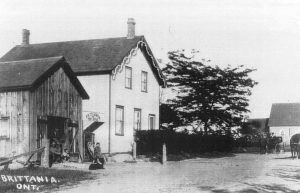 We made reference to Britannia Road in an earlier article – the road is named for the community it led to – but we did not talk about the community itself.
We made reference to Britannia Road in an earlier article – the road is named for the community it led to – but we did not talk about the community itself.
Driving along the busy thoroughfares of Hurontario Street or Britannia Road today, people may not notice the “Welcome to Britannia” road signs. The historic community of Britannia, with only a handful of physical reminders from the past, has become one of our “lost villages” in Mississauga.
 Originally referred to as “Gardner’s Clearing” in 1821, after two Gardner brothers established farms at the crossroads of what is now Britannia Road and Hurontario Street. A travelling Methodist preacher, Cornelius Flummerfelt, recorded a visit here in the spring of 1821.
Originally referred to as “Gardner’s Clearing” in 1821, after two Gardner brothers established farms at the crossroads of what is now Britannia Road and Hurontario Street. A travelling Methodist preacher, Cornelius Flummerfelt, recorded a visit here in the spring of 1821.
 By 1830, many more families had begun to settle around the crossroads, and Joseph Gardner donated the land for a church and graveyard. The church, built in 1843, survives today at the southeast corner of the intersection, although it faces an uncertain future.
By 1830, many more families had begun to settle around the crossroads, and Joseph Gardner donated the land for a church and graveyard. The church, built in 1843, survives today at the southeast corner of the intersection, although it faces an uncertain future.
 The first post office opened under Postmaster Joseph Muir in 1863, and the community officially became “Britannia”, and the unofficially-called “Elmbank Sideroad” gradually became known as Britannia Road. Over time Britannia added a wagon shop, schoolhouse, carpenter shop, a cabinet-maker, general store and a blacksmith shop.
The first post office opened under Postmaster Joseph Muir in 1863, and the community officially became “Britannia”, and the unofficially-called “Elmbank Sideroad” gradually became known as Britannia Road. Over time Britannia added a wagon shop, schoolhouse, carpenter shop, a cabinet-maker, general store and a blacksmith shop.
 Another surviving reminder of Britannia is the Old Britannia Schoolhouse on the west side of Hurontario Street, just south of Matheson Boulevard. Built in 1852, this schoolhouse served children from the surrounding area until 1959. In 1982 it was restored and today is lovingly cared for by the “Friends of the Schoolhouse” and play’s a significant role in the elementary education in Peel today. Also located on the adjacent farm property surrounding the school is a storey-and-a-half farmhouse, typical of the early Peel landscape, and original to the property. Beside it is a larger Georgian-style house, known as the Gardner-Dunton House, which is believed to have been built in 1840 and was relocated to the current property in 1989. These structures help to root us to a not-so-distant agricultural and rural past.
Another surviving reminder of Britannia is the Old Britannia Schoolhouse on the west side of Hurontario Street, just south of Matheson Boulevard. Built in 1852, this schoolhouse served children from the surrounding area until 1959. In 1982 it was restored and today is lovingly cared for by the “Friends of the Schoolhouse” and play’s a significant role in the elementary education in Peel today. Also located on the adjacent farm property surrounding the school is a storey-and-a-half farmhouse, typical of the early Peel landscape, and original to the property. Beside it is a larger Georgian-style house, known as the Gardner-Dunton House, which is believed to have been built in 1840 and was relocated to the current property in 1989. These structures help to root us to a not-so-distant agricultural and rural past.
These are but a few physical remnants of Britannia that survive in modern Mississauga. More valuable still are the rich memories and stories of the community that survive, in no small part due to the efforts of former Britannia residents Marjorie and Ben Madill, who collected, and shared, a treasure trove of memories of their beloved Britannia.
NOTE: This story was previously published as part of the Way Back Wednesday series in Modern Mississauga by Heritage Mississauga.
It can be found on their website here: https://www.modernmississauga.com/main/2019/8/7/the-history-of-mississaugas-britannia-road



Comments are closed.